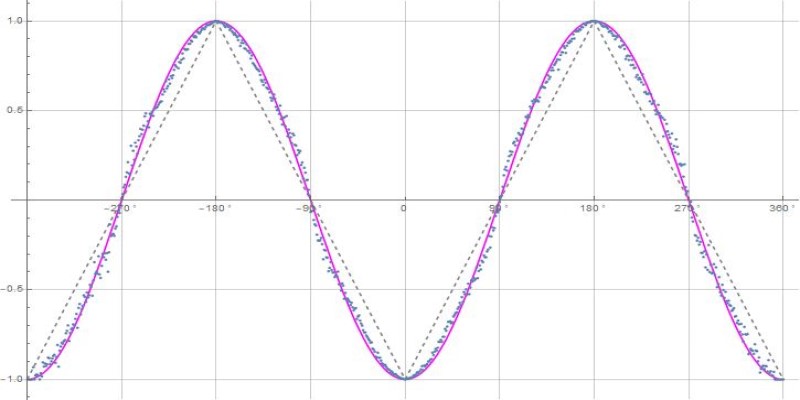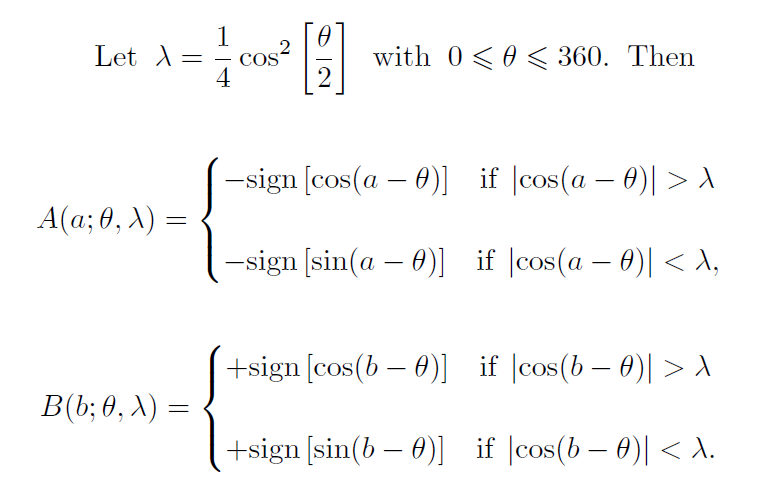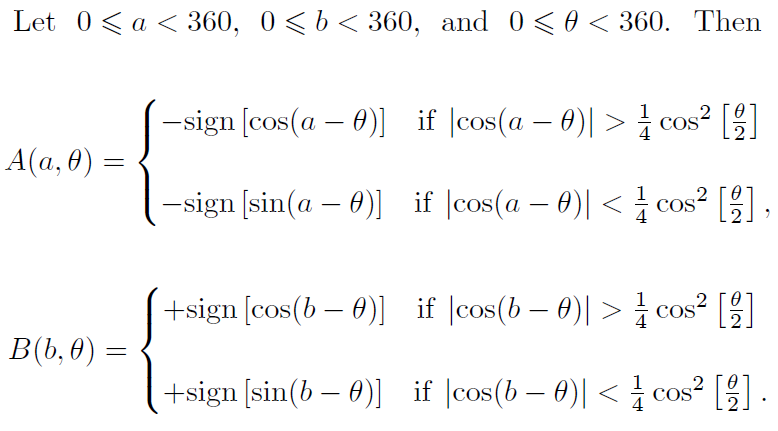Joy Christian wrote:.
Congratulations, Fred. Someone is converging to eating their hat in public, as they boasted some years ago!
.
Thanks. This is just the beginning of even more refinement.
.
Joy Christian wrote:.
Congratulations, Fred. Someone is converging to eating their hat in public, as they boasted some years ago!
.

FrediFizzx wrote:Ok folks, as promised here is the super-duper ultra local realistic model that Gill said was impossible. It is time for Gill to post a video somewhere showing him eating his hat.One million trials at one degree resolution and I went to a more simple model to help speed it up. Took one day of processing mainly because of the trial number matching functions. If you have one million events then they have to do one trillion calculations more than one time. Three separate Do loops. A and B are run at completely different times.
Here are the Mathematica PDF and notebook files.
EPRsims/newCS-10-forum.pdf
EPRsims/newCS-10-forum.nb
Enjoy!!!! There is absolutely no doubt now that Bell is dead, dead, dead and shot down for good.


.
FrediFizzx wrote:@gill1109
You have the Mathematica code so knock your lights out and do whatever you want. I'm not interested in doing anything else since I know what it is exactly and it works. Well..., except write up a paper about it and get it published. I was thinking of the title, "Bell's 'theorem' was always just a theory and now it is nothing".


Here is the CHSH version.
CHSH = 2.64946
Here are the files.
EPRsims/newCS-10-CHSH-forum.pdf
EPRsims/newCS-10-CHSH-forum.nb
Enjoy!!!
jreed wrote:I just downloaded your latest version in Mathematica, and tried setting lambda = 0 in the do loop over angles. I got a CHSH result of 1.993. This indicates that lambda is that old detection loophole, and if it is zero, you will get the usual classic result.
FrediFizzx wrote:jreed wrote:I just downloaded your latest version in Mathematica, and tried setting lambda = 0 in the do loop over angles. I got a CHSH result of 1.993. This indicates that lambda is that old detection loophole, and if it is zero, you will get the usual classic result.
10,000 particles in and 10,000 detected. Check that. Of course we don't want the HV to ever be zero. No point to that.
.

FrediFizzx wrote:
Thanks Joy. Yes, we were able to simplify that a bit. Looks good. Most all the rest of the Mathematic programming is for getting the trial numbers matched up correctly.

A <- function(a, th) {
ifelse(abs(cos(a - th)) > 0.25 * cos(th / 2)^2,
-sign(cos(a - th)),
-sign(sin(a - th)))
}
B <- function(b, th) -A(b, th)
N <- 10^6
th <- runif(N, 0, 2*pi)
a <- 0
b <- pi/4
mean(A(a, th) * B(b, th))
-cos(a - b)
Austin Fearnley wrote:Hi Fred
Not sure about the confusion?
Today, I have run your formulae (the ones very recently posted above in this thread) in an excel spreadsheet and found abs correlation to be 0.495650509
for a = 0 degrees and b = 45 degrees. I only used 360 pairs at evenly spaced values of theta.
This does not beat the classical Bell correlation of 0.5.
Note that IMO it is possible to use a spreadsheet for these formulae rather than a computer program (and I have done it).
(BTW I found the very recent formulae posted by you and Joy very useful whereas I was not inclined to try to interpret your posted computer code.)
Best, Austin
Guest wrote:R code using the formulas provided by Joy Christian in the image title "Fred's Disproof of Bell's Theorem".
- Code: Select all
A <- function(a, th) {
ifelse(abs(cos(a - th)) > 0.25 * cos(th / 2)^2,
-sign(cos(a - th)),
-sign(sin(a - th)))
}
B <- function(b, th) -A(b, th)
N <- 10^6
th <- runif(N, 0, 2*pi)
a <- 0
b <- pi/4
mean(A(a, th) * B(b, th))
-cos(a - b)
Guest wrote:R code using the formulas provided by Joy Christian in the image title "Fred's Disproof of Bell's Theorem".
- Code: Select all
A <- function(a, th) {
ifelse(abs(cos(a - th)) > 0.25 * cos(th / 2)^2,
-sign(cos(a - th)),
-sign(sin(a - th)))
}
B <- function(b, th) -A(b, th)
N <- 10^6
th <- runif(N, 0, 2*pi)
a <- 0
b <- pi/4
mean(A(a, th) * B(b, th))
-cos(a - b)
Return to Sci.Physics.Foundations
Users browsing this forum: No registered users and 246 guests
